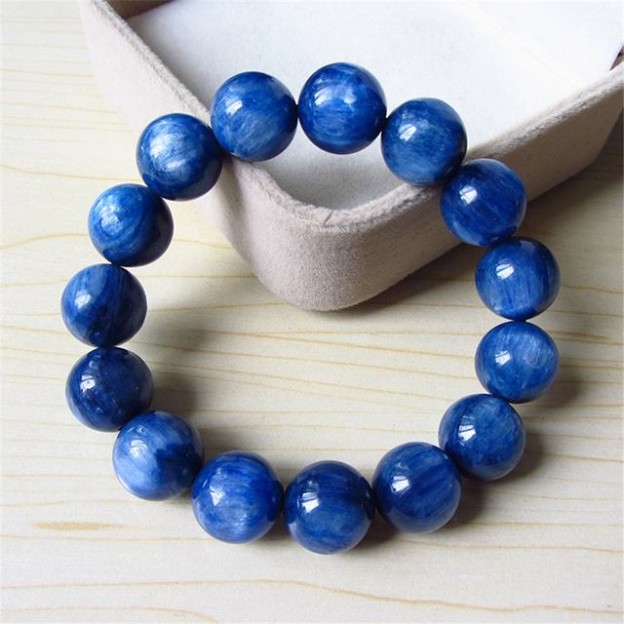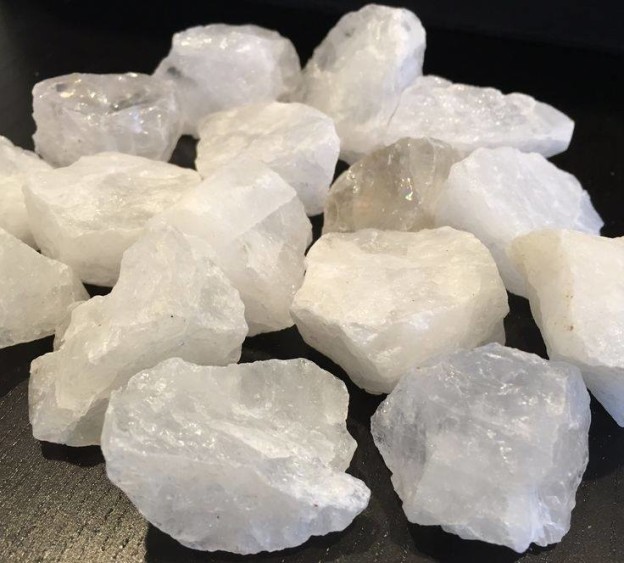Kyanite (from the Greek “kyanos”) – blue. Another name for the stone is “disten” (from the Greek “dis sthenos”) – a double fortress. Kyanite – an exotic stone, rarely found in jewelry. In ordinary jewelry stores, you will not see it, and you can find it only from private craftsmen, minerals sellers or collectors.
Origin and chemical composition
Kyanite is an aluminum silicate and refers to rock-forming minerals. It is formed with deep metamorphism of sedimentary rocks rich in alumina, is also found in quartz veins and contact zones of pegmatites. The coloration of kyanites can vary depending on the impurities of the compounds of iron, chromium, titanium and manganese. Traditional color – blue or blue, there are also green, yellow, purple, colorless or almost black kyanites.
The hardness of the stone is very different in different directions. This mineral is found in the form of elongated lamellar crystals with perfect cleavage in one direction parallel to the elongation. Hardness 5,0 (scratching with a knife) in the direction of elongation of the plate and 7,0 (not scratched by the knife) in the perpendicular direction. This property distinguishes kyanite from other precious stones. Blue and bluish-green crystals are distinguished by higher refractive index and density.
Physicochemical properties of kyanite
- The chemical formula is Al2O (SiO4).
- Color – blue, sky blue to almost colorless.
- Singonia is triclinic.
- The hardness is 4.5-6 on the Mohs scale.
- The density is 3.5-3.7 g / cm3.
- Fracture – fibrous.
- Glitter – glass.
Varieties of kyanite
Kyanites can be dark blue, purple, yellow, and green, colorless, black. There are also crystals with the effect of “cat’s eye”. There are even kyanites with pleochroism (alexandrite effect) – a change in color depending on the angle of view. The color of such stones can vary from cobalt blue and violet to green. Ornaments with kyanite look best in daylight.
Processing and use
Kyanite is used today mainly as industrial raw materials – for the production of high-strength refractory and acid-resistant materials. It is also used in the production of insulators, crucibles for casting steel, spark plugs in the automotive industry, as well as for the creation of aluminum-silicon alloys. He even received the names of the stone of the new millennium and the stone of the 21st century. Kyanite is also used in the ceramic industry for the production of sinks, baths, and tiles.
In the jewelry business, transparent stones are used. They are cabochoned, inserted into earrings, pendants or made from them beads and bracelets. Kyanite is difficult to handle because of its ability to crack easily. At the same time, after polishing, the stone acquires a noble appearance and shine. Ornaments with kyanite look great in daylight.
Long since, the blue-colored crystals have been grinded and sold to inexperienced customers in the guise of sapphires. Indeed, a jewel stone of deep blue color of high transparency and purity can easily be mistaken for sapphire. However, if you take a good look, you can notice that the kyanite is colored unevenly – with stripes.
Deposits of kyanite
The deposits of jewelry kyanites exist almost all over the world. The first place in the extraction of industrial kyanite is occupied by the USA and India. The US Congress in 1984 declared it a strategic material and this could mean, among other things, that it was used in secret industries. In the US, stones are mined in the states of Montana, Virginia, Vermont, Connecticut, Massachusetts, South and North Carolina, Georgia. There are deposits in India, Myanmar, Burma, Kenya, Tanzania, Zimbabwe, Australia, Brazil, Austria, Finland, Serbia, Spain and Switzerland. Kyanites of bright blue sapphire are found in the foothills of Nepal.
In Russia, deposits of celestial blue and violet kyanites are found in the Urals. Their spindle-shaped crystals are called oatmeal. Transparent beautifully painted kyanites can also be found in the Arkhangelsk region and the Kola Peninsula.
Imitation and synthetics
Jewelry transparent kyanite deep blue color of high purity can be taken for sapphire, but it is softer than sapphire, and in a crystal it cannot be confused with sapphire. Lighter, watery-blue kyanites are very similar to aquamarine, especially the shape of crystals. If it is noticeable that the color is distributed unevenly in the gem, by strips, then it certainly kyanite.
Magical properties of kyanite
Kyanit is considered a talisman of travelers. It has been known for a long time that a crystal of kyanite suspended on a human hair or silk thread always turns to the north with the same end. For this reason, travelers often took a crystal of kyanite with them, especially if they went to unexplored land.
It is believed that kyanite makes its owner more reasonable, faithful, modest, and prudent. This stone is simply necessary for people who are prone to all sorts of adventures and love affairs.
As a talisman, a kyanite helps a person concentrate on one thing, rather than throwing energy in vain, trying to do everything at once. Also kyanit helps to choose exactly the case, which will bring to its owner the greatest benefit – from material profit to achieving fame and success. Stone protects the owner from the perfidy of business partners, attracts to him the sympathy and trust of other people, helps to climb the career ladder, but only on the condition that the kyanite owner is a kind and decent person. This is the talisman of teachers, doctors, lawyers, bankers, businessmen and politicians.
Healing properties
Traditional healers believe that kyanite increases the general tone of the body, improves memory, facilitates the state of childhood infections, kidney and bladder diseases, relieves insomnia, removes the effects of stress.
Horoscope
Astrologers strongly recommend wearing kyanite to people born under the signs of Sagittarius and Gemini. It also suits Pisces, Cancers and Libra. This stone is contraindicated irresponsible, lazy, fraudulent people.
History
It is known that kyanites brought from India to Russia and Europe in the 16th century. In 1575 in Moscow was compiled “A descriptive book, how to lead young people to the nobility and the whole price,” and in part it describes “all kinds of land different goods, they are brought to Russia by the Germans and other lands people trading.” Later the book was supplemented with new information, including the description of kyanites: “A stone is a bous, siz, blue, and you do not buy a bass for the yawn.” Baus was brought from India, and it was assumed that in the course of trading he could be given out for a yakhont, that is, for a sapphire.
The name kyanite owes its name to a beautiful sky-blue color. In Germany, kyanite was formerly called a plank stone, because it forms elongated long-columned crystals, similar in structure to wood.
Crystal Quartz Pyramid
Pyramids are used for charging Crystals, meditation, massage and Healing Reiki. We supply highly polished powerful gemstone pyramids which are a must for healer. A crystal pyramid can be used to draw of Negative Energy and Generate Positive Energy.


